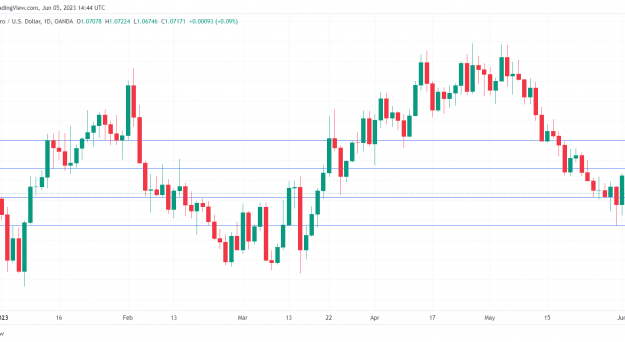- ECB’s Lagarde hints at further rate hikes
- US nonfarm payrolls surges to 339,000
- US unemployment rises to 3.7%
The euro has extended its losses on Monday and is trading at 1.0686, down 0.21%.
It was a brutal month of May for the euro, which plunged 2.98%. The euro started the month above the 1.10 line but a hawkish Federal Reserve and solid US numbers have boosted the US dollar. The debt ceiling crisis also buoyed the greenback, as investors were nervous about a US default. This dampened risk appetite and pushed the safe-haven US dollar higher.
Lagarde stays hawkish
The ECB meets on June 15th and President Lagarde reiterated her hawkish stance earlier today. Lagarde noted that “price pressures remain strong”. She added that “there is no clear evidence that underlying inflation has peaked”, repeating what she said last week. An improvement in the eurozone inflation picture doesn’t seem to have softened Lagarde’s stance – last week’s April inflation report showed headline inflation falling from 7.0% to 6.1% and the core rate eased from 5.6% to 5.3%.
Lagarde said that future rate decisions would be data-dependent and strongly hinted that more rate hikes were coming. There are no tier-1 releases prior to the June meeting, and barring some unusual developments, the ECB is likely to raise rates by 25 basis points, which would bring the benchmark cash rate to an even 4.0%.
Nonfarm payrolls surge, but unemployment climbs as well
Last week ended with a scorching nonfarm payrolls report, a reminder that hiring and job growth remain resilient. Payrolls surged by 339,000 in May, crushing the estimate of 195,000. The April reading was revised upwards to 294,000 from 253,000, another sign of strong growth. However, there was more to the story. The unemployment rate surprised to the upside, rising from 3.4% to 3.7%, while wage growth ticked lower to 0.3%, down from 0.4%.
The mixed job report shows that job growth remains robust but the labour market is also showing signs of cooling down, which is what the Fed desperately needs to wind up the current rate-tightening cycle. If the Fed chooses to focus on the softer portions of the employment report, it could be enough for the Fed to take a pause at the meeting next week, after ten consecutive rate increases.
.
EUR/USD Technical
- 1.0707 is a weak support line. Below there is support at 1.0636
- 1.0780 and 1.0851 are the next resistance lines
Content is for general information purposes only. It is not investment advice or a solution to buy or sell securities. Opinions are the authors; not necessarily that of OANDA Business Information & Services, Inc. or any of its affiliates, subsidiaries, officers or directors. If you would like to reproduce or redistribute any of the content found on MarketPulse, an award winning forex, commodities and global indices analysis and news site service produced by OANDA Business Information & Services, Inc., please access the RSS feed or contact us at info@marketpulse.com. Visit https://www.marketpulse.com/ to find out more about the beat of the global markets. © 2023 OANDA Business Information & Services Inc.




